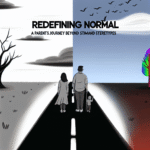
From Denial to Acceptance: The Ultimate Comprehensive Guide to the Stages of Grief
Grief is an emotional journey that transcends mere sadness; it is a multifaceted experience shaped by our deepest attachments, losses, and the very essence of who we are. When faced with loss, whether it be the death of a loved one, the end of a relationship, or any significant life change, many find themselves navigating through complex emotional stages. In this guide, From Denial to Acceptance: A Comprehensive Guide to the Stages of Grief, we will unpack these stages, provide practical insights, share relatable case studies, and offer tools that encourage healing and acceptance.
Introduction: Understanding the Journey of Grief
Imagine losing someone you love deeply. The initial shock can be overwhelming, plunging you into a state of disbelief where the mind refuses to accept the reality of the situation. This experience is not just an emotional reaction; it’s a fundamental part of the human condition. Grieving is an inevitable, yet profoundly personal journey that varies from individual to individual. This guide aims to illuminate the path from denial to acceptance, emphasizing a deep understanding of the emotional stages we traverse.
Why This Guide is Essential
Understanding the stages of grief is crucial for several reasons. First, it provides a roadmap for those in mourning, allowing individuals to identify their feelings and validate their experiences. Second, it helps friends and family understand how to best support those who are grieving. Finally, it reveals that acceptance is not an endpoint but a continuous journey towards healing. As we explore this comprehensive guide, remember that reaching acceptance may not mean forgetting; instead, it embodies the integration of loss into our lives.
The Stages of Grief: An Overview
The concept of the stages of grief was introduced by Elisabeth Kübler-Ross in 1969, primarily focusing on terminally ill patients. Over time, these stages—denial, anger, bargaining, depression, and acceptance—have become widely recognized and utilized in understanding not just terminal illness, but all forms of significant loss. This guide will delve into each stage, providing clarity and insights on how they manifest in real life.
1. Denial: The Protective Shield
Denial serves as a defense mechanism, shielding us from the immediate shock of loss. It is the brain’s way of coping with an event that feels too painful to accept.
Case Study 1: Emily’s Journal Entry
Emily, a 33-year-old woman, lost her mother unexpectedly. For weeks, she found herself pacing her home, expecting her mother to walk through the door. Her first journal entries detailed a surreal existence where she could not face the truth.
Analysis: Emily’s denial was a temporary sanctuary. It illustrates how denial can prevent one from confronting overwhelming feelings, but it is often a phase that must eventually be crossed.
2. Anger: The Eruption of Emotion
Once the protective shield of denial starts to crack, anger often emerges. This anger can be directed at oneself, other people, or even the deceased.
Case Study 2: Mark’s Outburst
Mark lost his best friend in an accident and found himself furious at the universe, friends, and even at the deceased for leaving him behind. This anger manifested in moments of frustration and isolation from those around him.
Analysis: Mark’s angry outbursts demonstrate the struggle to redirect raw emotions, reminding us that anger is a common, albeit distressing, reaction to loss. Accepting this stage is critical for moving forward.
3. Bargaining: Seeking a Trade-off
During the bargaining phase, individuals attempt to negotiate their way out of the grief. This might involve making promises to a higher power in exchange for relief from the pain.
Case Study 3: Sarah’s Promise
Sarah, grieving the loss of her partner, found herself praying daily, asking for a second chance to right her wrongs. She became actively involved in charitable work, convinced that if she did good, life would return to normal.
Analysis: Sarah’s bargaining not only highlights the desperation in grief but also shows how it can motivate individuals to seek purpose through altruism, fostering personal growth.
4. Depression: The Deep Dive
As reality sets in, many move into the phase of depression. This stage can feel heavy, characterized by sadness, despair, and emotional withdrawal.
Case Study 4: John’s Isolation
John lost his father at a young age and fell into a deep depression that lasted years. He distanced himself from friends and family, feeling unworthy of their support.
Analysis: John’s experience underscores the importance of recognizing depression as a natural consequence of grief. It highlights the need for open conversations and support systems to prevent long-term emotional damage.
5. Acceptance: A New Beginning
Acceptance does not mean forgetting or moving on; rather, it signifies the realization that life has changed and that one can find a new normal.
Case Study 5: Lisa’s Resilience
After years of mourning her sister, Lisa found strength in honoring her memory through art. She began a blog to share her journey, connecting with others experiencing similar losses.
Analysis: Lisa’s story exemplifies that acceptance can lead to healing and transformation. It is a testament to the ability to find meaning in loss, creating pathways to resilience.
Navigating the Stages: Tips and Strategies
Self-Care: Prioritizing Mental Health
Self-care is essential throughout the grieving process. Here are some strategies to support your journey:
- Journaling: Write down thoughts and feelings to process emotions.
- Physical Activity: Engage in exercise to release endorphins and combat feelings of depression.
- Mindfulness and Meditation: Practice mindfulness or meditation to ground yourself when emotions feel overwhelming.
Support Systems: Leaning on Others
Building and maintaining a support system plays a crucial role in navigating the stages of grief:
- Reach Out: Don’t hesitate to ask friends and family for support. Share your feelings, and don’t suffer in silence.
- Support Groups: Joining support groups can provide a sense of community and normalization of the grieving process.
Professional Help: When to Seek Guidance
If grief feels unmanageable or leads to major disruptions in life, consider seeking professional help. Therapists specializing in grief can provide valuable tools for healing.
Visualizing Grief: Stages of Grief Table
| Stage | Description | Emotional Indicators |
|---|---|---|
| Denial | Refusal to accept reality | Shock, numbness, disbelief |
| Anger | Outward frustration | Rage, irritation, blame |
| Bargaining | Attempting to negotiate | Guilt, remorse, hope |
| Depression | Deep sadness and withdrawal | Isolation, despair, emptiness |
| Acceptance | Acknowledgment and adjustment | Peace, stability, gratitude |
Conclusion: Embracing the Journey from Denial to Acceptance
Grieving is an intricate dance through emotional landscapes, and the journey from denial to acceptance is uniquely personal. By understanding these stages and recognizing that they can overlap or return at any moment, individuals can navigate their path toward healing with greater compassion for themselves.
As you embrace your journey, remember that acceptance is not the end; it is a new beginning that allows for the integration of loss into the fabric of life. It’s about finding a way to honor what was lost while continuing to forge ahead.
Frequently Asked Questions (FAQs)
1. How long does each stage of grief last?
The duration varies widely for each person. Some might spend days in denial, while others could linger months in depression. Recognizing that there is no timeframe for grief is essential.
2. Is it normal to skip stages or revisit them?
Absolutely. Grief is not linear. Many individuals find themselves revisiting stages multiple times throughout the process.
3. Can grief affect physical health?
Yes, grief can lead to a range of physical symptoms such as fatigue, headaches, and changes in appetite. It’s crucial to take care of your physical health during this time.
4. How can I help a friend who is grieving?
Listen without judgment. Be present, offer help with daily tasks, and encourage them to share their feelings. Sometimes, your mere presence is enough.
5. What should I do if I feel stuck in one stage?
If you feel stuck, seeking professional help can provide clarity and healing. Therapists can offer new strategies and tools to help you progress through your grief journey.
In this ultimate guide, From Denial to Acceptance: A Comprehensive Guide to the Stages of Grief, we explored the intricate stages of grief, enriched with personal stories and actionable insights. Remember, while grief is a deeply individual experience, you’re not alone on this journey. Embrace your emotions, take care of yourself, and honor your path towards acceptance.















